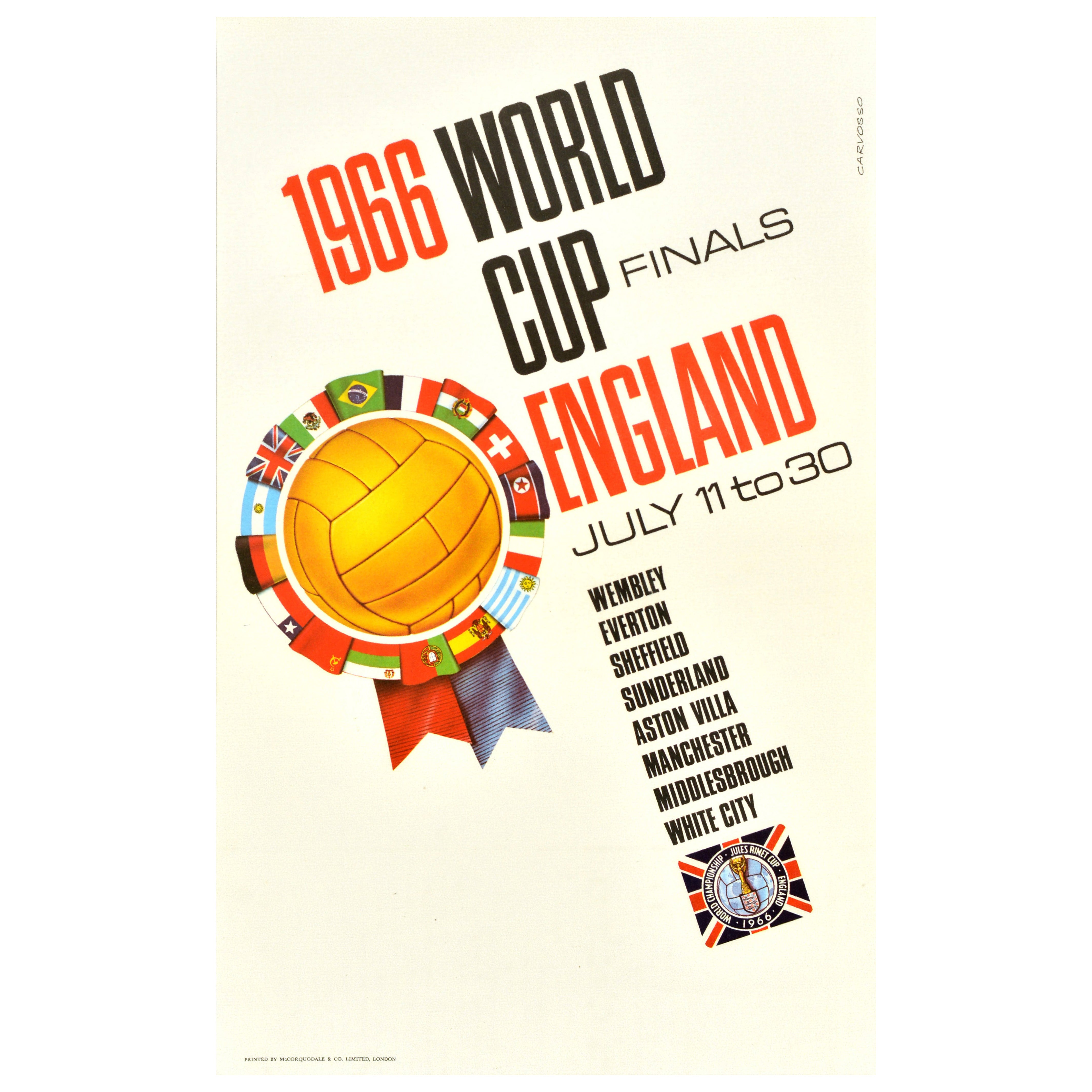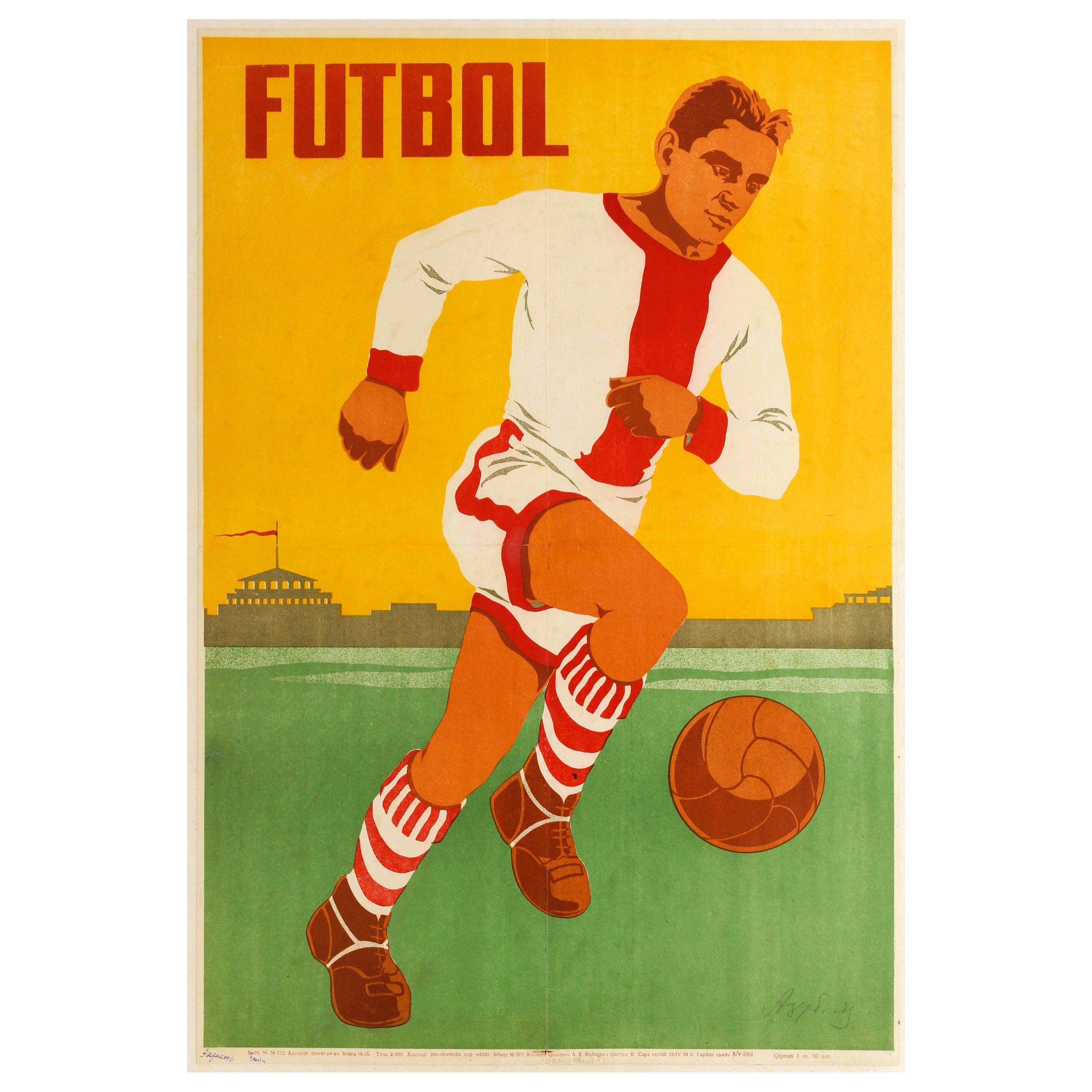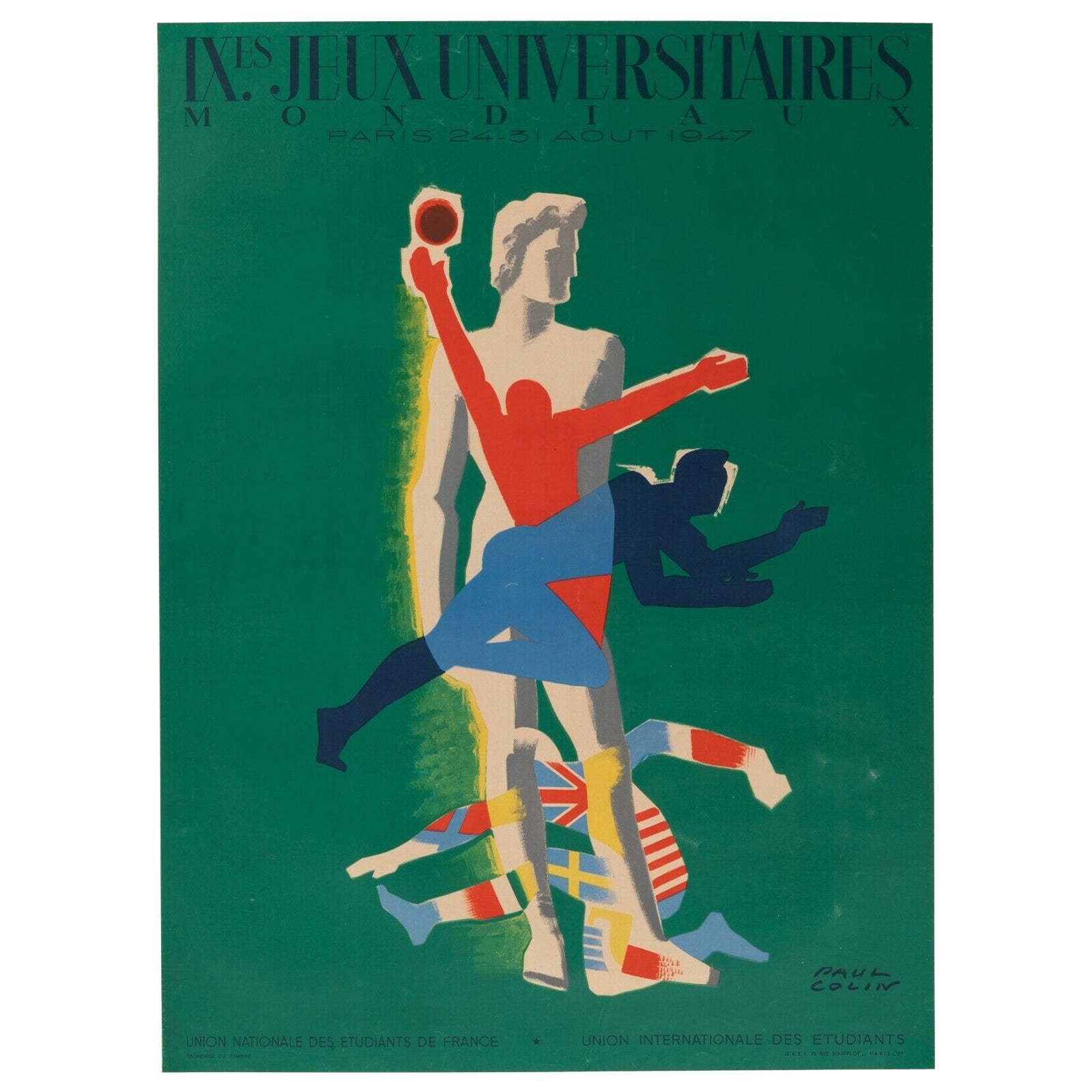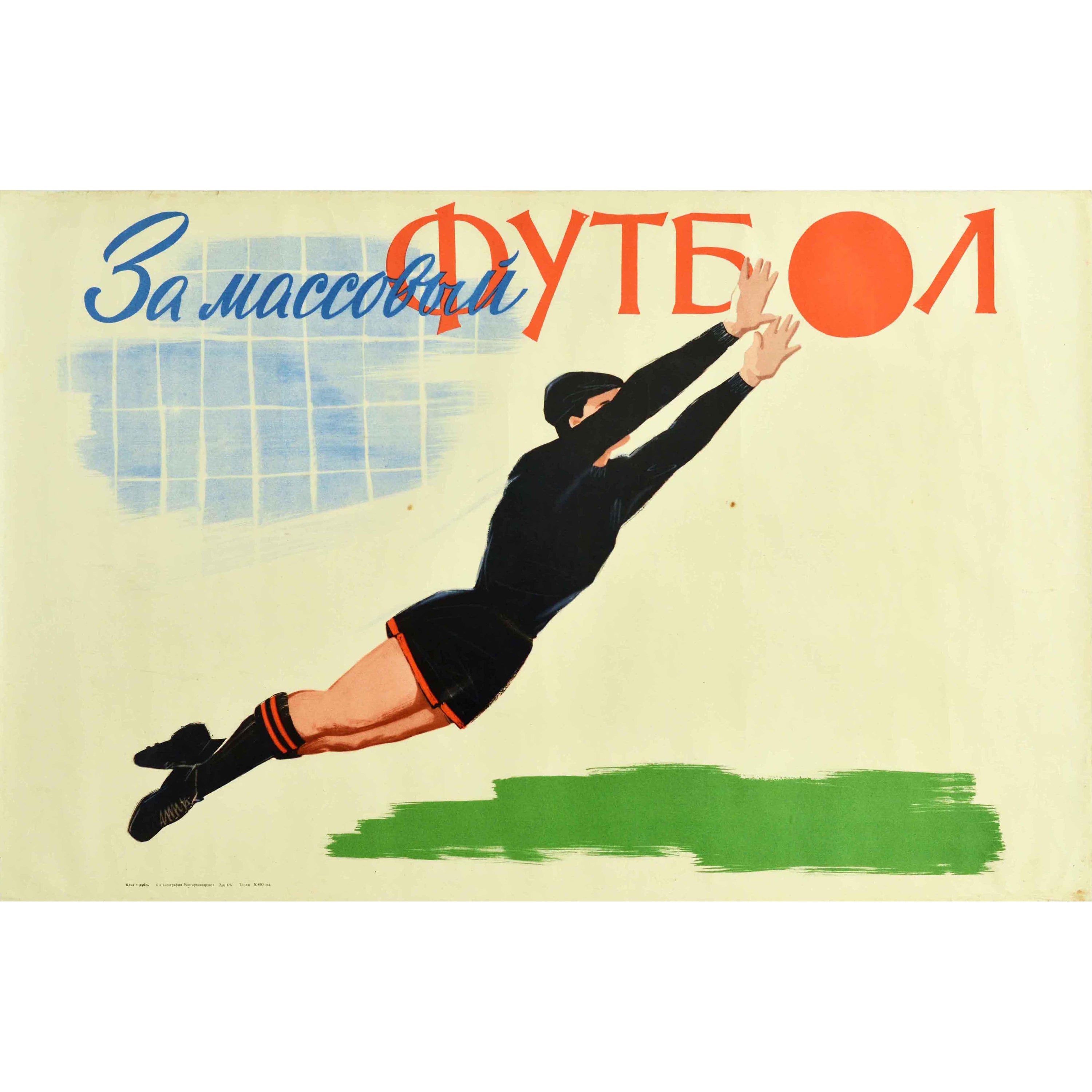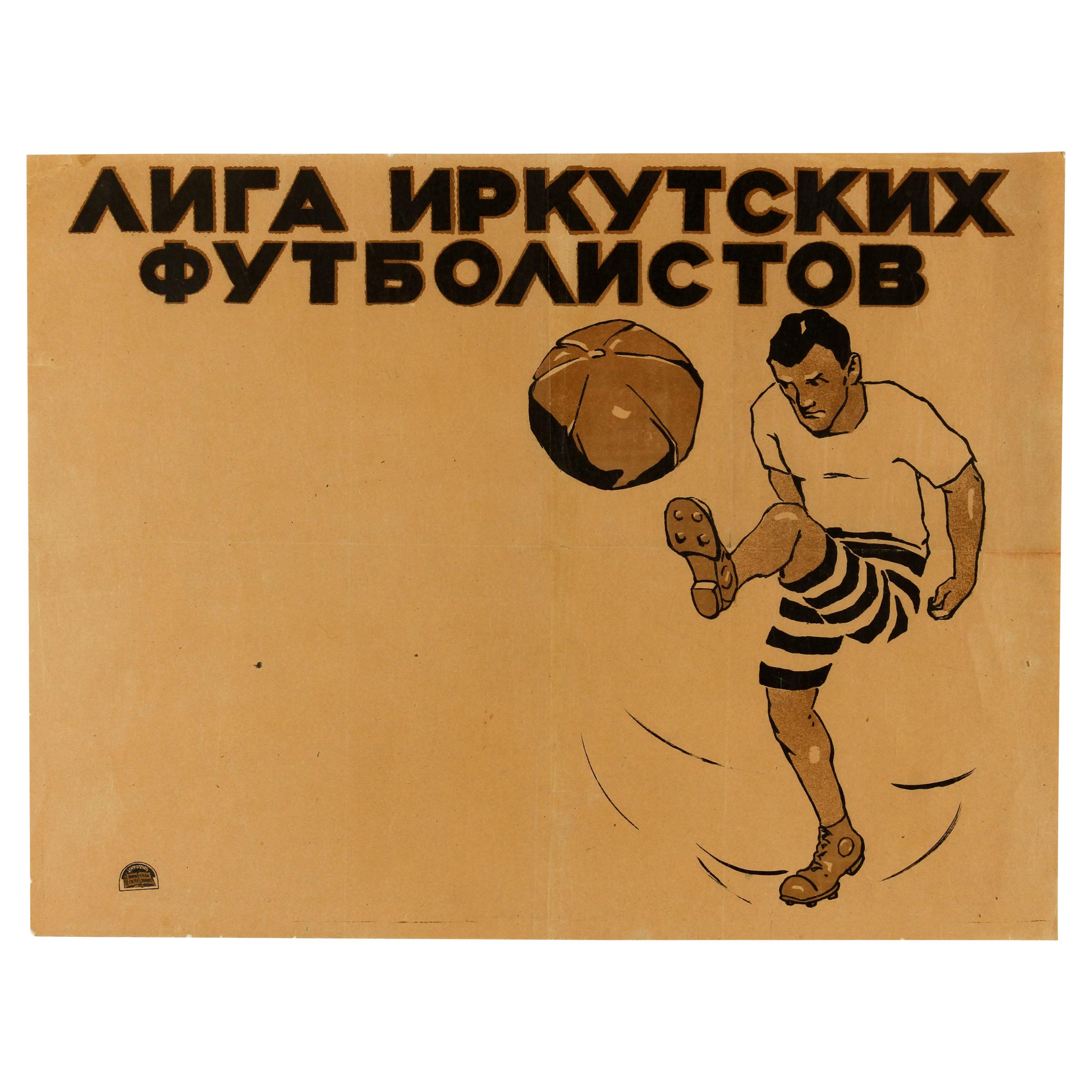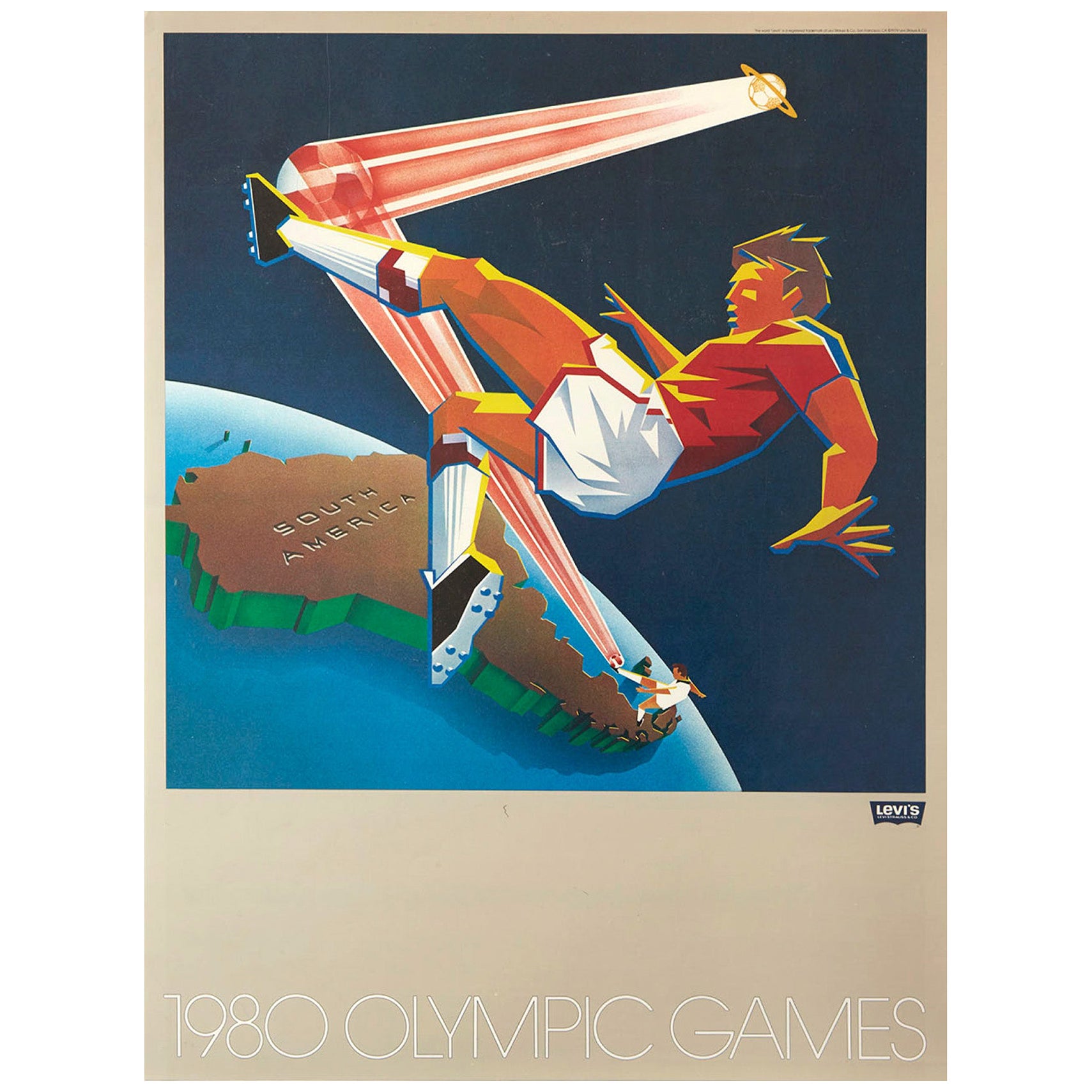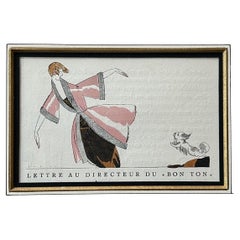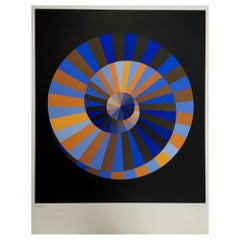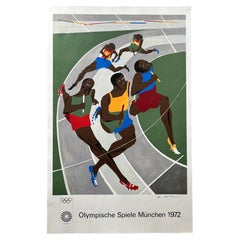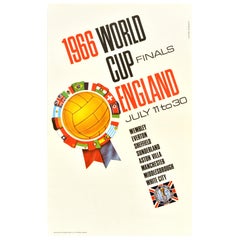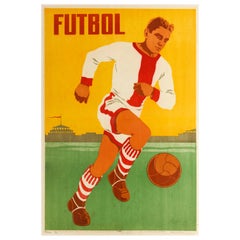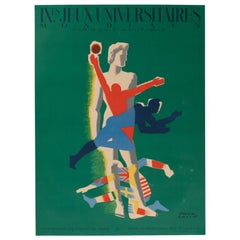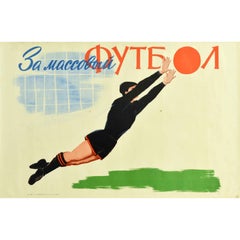Items Similar to A 1930 Inaugural World Cup Poster
Want more images or videos?
Request additional images or videos from the seller
1 of 8
A 1930 Inaugural World Cup Poster
$6,303.94
£4,600
€5,366.65
CA$8,634.82
A$9,603.80
CHF 5,014.81
MX$116,868.02
NOK 64,046.72
SEK 60,064.52
DKK 40,053.34
Shipping
Retrieving quote...The 1stDibs Promise:
Authenticity Guarantee,
Money-Back Guarantee,
24-Hour Cancellation
About the Item
A truly rare poster from the officially issued monochrome version of the 1930 World Cup poster bearing the all-important official stamp of the Comite Ejectivo of the governing body of football in Uruguay.
The 1930 FIFA World Cup was the inaugural FIFA World Cup, the world championship award for men’s national association football teams. The tournament was held in Uruguay from 13th to 30th July, 1930.
Dimensions: 52 × 28 cm
Condition: Very good for age devoid of tears, creases or excessive age-toning and with a few printer’s roller-marks that provide the poster with its own innate provenance and authenticity
The 1930 Word Cup Poster
Two types of posters were commissioned by the Uruguayan Football
Federation, AUF for the tournament. They were the Official Poster in colour (78.5 ×
38 cm; 38 × 15 in) and a smaller monochrome version of the Official Poster with the
official stamp of the Comite Ejecutivo (52 × 28 cm; 201/2 by 11 in) designed by the
Uruguayan graphic artist, Guillermo Laborde who had by that time acquired an
international reputation.
The colour posters were to be given to the participating teams and officials
connected with the staging of the event and dignitaries, both local and foreign,
mostly from the neighbouring Latin American countries. Research indicates that
there were only two types of the colour posters, both having the same characteristics
except some had the printer’s mark and the others were without this mark.
Biographical Details of Guillermo Laborde
Guillermo Laborde studied at the Circulo Estimulo de Bellas de’ Artes with Carlos
Maria Herrera in Buenos Aires, before travelling to Europe between 1910 and 1912
visiting Florence, Milan, Rome, Paris and Spain. On his return to South America his
work was widely exhibited in Uruguay, Argentina, Peru and Ecuador and was the
winner of various art awards. In view of his recognition in the Uruguayan art world,
Laborde was originally selected as a juror on the panel that was formed to select the
winner of the competition to design the official poster for the historic first World Cup
of 1930. However, he subsequently decided to resign from the jury as he wished to
enter the competition himself.
Laborde in fact entered two designs and finished first and third. In later life he
became a teacher at the Circulo Estimulo de Bellas de’ Artes, the Escuela de la
Construccion and the Instituto Magisterial. Laborde also forged close links with the
theatre, managing stage design at the Casa del Arte.
Additional Details Relating to the Monochrome Poster
The monochrome poster as here reads in Spanish: ‘Soccer World Championship /Montevideo, Uruguay / 15 July – 15 August’. The poster also carries the original blue stamp of the Comite Ejecutivo, marked 1930.The poster created in Art Deco style, depicts in its upper half a stylised figure of a faceless goalkeeper lurching upwards in a valiant attempt to stop a ball aimed at the top right-hand corner of the goal posts from entering the goal area, with the position of the ball shown by placing the crossbar and the right-hand goal post at the back of it in an angular fashion. The lower half contains writing in a heavily stylized font: ‘1er Campeonato Mundial de Futbol’ in black, and ‘Uruguay 1930 Montevideo 15 Julio Augusto 15’. The I is shown enlarged and prominent to emphasise the historical fact that it is the First World Football Championship. The vivid imagery enshrined in this most iconic of sports posters strikingly reflects the creative imagination and the consummate skills of a graphic artist at the height of his career. This iconic and historic poster has come to be known as the ‘Laborde Affiche’. The posters were published by Olivera y Fernandez of Reconquista 624, Montevideo.
General Comments on the 1930 WC Poster
Very few of the colour posters are known to have survived, especially as the print run was small. A colour poster in very good condition, without losses, tears, nicks or creases or discolouration's if it ever appeared in today’s retail market (2022) could fetch a price as high as £50,000.
A lot more of the monochrome version were printed for general publicity and advertising purposes and to be distributed to football fans, local and foreign, but mostly from neighbouring Latin American countries. However, only a very few are thought to be in existence today in a good collectible condition, without blemishes like losses, tears or discolourations and/or deeply marked creases or heavy age-toning.
Specific Comments on the Poster on Offer for Sale
After a decade-long search for the monochrome poster in Uruguay, in particular Montevideo, using a network of local agents, we managed to find a few prints in the possession of a descendant of the original publisher of the poster in very good condition for their age.
It was abundantly clear to us that he had looked after them with extreme care, subscribing to the highest standards expected of a custodian of a much-cherished family heirloom and fully aware of its historical significance.
It was after prolonged negotiations with him that he agreed to sell them to us. To him, their preservation for decades to come, for posterity was the predominant concern. Since their purchase we have done everything to honour the undertaking we gave him.
Background Information
The 1930 FIFA World Cup was the inaugural FIFA World Cup tournament, the world championship award for men’s national association football teams. It was held in Uruguay from 13th to 30th July, 1930.
FIFA, football’s international body governing, selected Uruguay as the host nation, acknowledging the twin-facts that in 1930 the country would be celebrating the centenary of its first constitution, and the Uruguay national football team had successfully retained their football title at the 1928 Olympic Games.
All the matches were played in the capital of Uruguay, Montevideo, the majority at the Estadio Centenario, which was specially built for the tournament.
Thirteen teams (seven from South America, four from Europe and two from North America) entered the tournament. Only a few Europeans teams chose to take participate because of the difficulty of travelling to South America at the time. The teams were divided into four groups, with the winner of each group progressing to the semi-finals. The first two World Cup matches took place simultaneously, and were won France and the United States, who defeated Mexico 4-1 and Belgium 3-0, respectively. Lucien Laurent of France scored the first goal in World Cup history,
while the US goalkeeper, Jimmy Douglas posted the first official ‘clean sheet’ in the tournament. Argentina, Uruguay, the United States and Yugoslavia won their respective groups to qualify for the semi-finals. In the final, the host-nation and pre-tournament favourite, Uruguay defeated Argentina in front of a crowd of 68,346 people, and became the first footballing nation to win the World Cup.
- Dimensions:Height: 52 in (132.08 cm)Width: 28 in (71.12 cm)Depth: 1 in (2.54 cm)
- Style:Mid-Century Modern (Of the Period)
- Materials and Techniques:
- Place of Origin:
- Period:
- Date of Manufacture:1930
- Condition:
- Seller Location:Pewsey, GB
- Reference Number:1stDibs: LU7343239181012
About the Seller
No Reviews Yet
Vetted Professional Seller
Every seller passes strict standards for authenticity and reliability
1stDibs seller since 2022
9 sales on 1stDibs
- ShippingRetrieving quote...Shipping from: Marlborough, United Kingdom
- Return Policy
Authenticity Guarantee
In the unlikely event there’s an issue with an item’s authenticity, contact us within 1 year for a full refund. DetailsMoney-Back Guarantee
If your item is not as described, is damaged in transit, or does not arrive, contact us within 7 days for a full refund. Details24-Hour Cancellation
You have a 24-hour grace period in which to reconsider your purchase, with no questions asked.Vetted Professional Sellers
Our world-class sellers must adhere to strict standards for service and quality, maintaining the integrity of our listings.Price-Match Guarantee
If you find that a seller listed the same item for a lower price elsewhere, we’ll match it.Trusted Global Delivery
Our best-in-class carrier network provides specialized shipping options worldwide, including custom delivery.More From This Seller
View AllA Set of Six Highly Decorative Art Deco French Advertising Prints
Located in Pewsey, GB
A Set of Six Highly Decorative Unframed Art Deco French Advertising Prints all mounted, cellophaned and line drawn and coloured around print ready to go in a frame of your choosing....
Category
Vintage 1920s French Art Deco Prints
Materials
Paper
Munich 1972 Olympic Games Ltd Edition 'Spirale' Emblem Official Poster Signed
Located in Pewsey, GB
Rare Munich 1972 Olympic Games Limited Edition 'Spirale' Emblem Official Poster designed by Otl Aicher, Coordt von Mannstein and Victor Vasarely and signed...
Category
Vintage 1970s German Modern Posters
Materials
Paper
A Reproduction 1932 – 33 ‘Bodyline Tour’ signed Sir Donald Bradman
Located in Pewsey, GB
A reproduction imprint of the Iconic 1932 – 33 ‘Bodyline Tour’ poster specially signed by Sir Donald Bradman
This reproduction imprint of the iconic travel poster created for the 1932-33 ‘bodyline’ Ashes series entitled ‘Go Out to Australia for the Test Matches September 1932- March 33’ has been specially signed by the all-time greatest batsman, Sir Donald Bradman towards the centre of its image.
The original poster was published by Troedel and Cooper Pty Ltd Melb. It was reproduced with permission of the Percy Trompf Estate and published by Post-Age Pty Lid (Sydney).
Dimensions:
Height - 89 cm
Width - 63.5 cm
Condition – Very Good
This poster was created by Percival Alfred Trompf (1902 – 1964). Trompf was an Australian commercial artist best known for his travel posters, books, advertising hoardings and pamphlets promoting the nation’s tourist industry and Australian and international corporations and companies. His colour lithography was recognised as distinctive during his career and since, Art Decoin style, and innovative in its use of flat colour.
Sir Donald George Bradman (27 August 1908 – 25 February 2001) known as Don Bradman and nicknamed ‘The Don’ was an Australian international cricketer who was regarded as the greatest batsman of all time. His career Test batting average of 99.94 collected over 52 matches is considered by some commentators to be the greatest achievement by any sportsman in any major sport.
Before the 1932-33 Ashes tour, Douglas Jardine, the captain of England noted that Bradman was uncomfortable facing deliveries higher than usual at a faster pace, having observed him to step back consistently out of the line of the ball.
Jardine felt that Bradman was nervous about standing his ground against intimidatory bowling, contrary to orthodox batting technique and decided that the bodyline bowling tactic should be used against him and other top batsmen in forthcoming test matches.
Bodyline bowling was a cricketing tactic devised by English cricket team for their 1932-33 Ashes tour to Australia to counter the extraordinary batting skills and prowess of Australia’s leading batsman, Donald ‘Don’ Bradman and curb his scoring.
A bodyline delivery was one in which the cricket ball crick was bowled at pace, aimed at the body of the batsman in the expectation that when he defended himself with his bat, a resulting deflection could be caught by one of several fielders placed close on the leg side.
At that time, no helmets or upper body protective gear was worn, and critics of the tactic, both in Australia and England, considered it intimidating, overly aggressive, physically threatening and unfair, in a game that was traditionally supposed to uphold traditions of sportsmanship.
Over time, several of the Laws of Cricket were changed to render the bodyline tactic less effective and increase player safety.
This iconic poster reported to have been signed by The Don as a special gesture for an Australian sports journalist ranks as a unique item of cricket memorabilia...
Category
Vintage 1980s British Modern Posters
Materials
Paper
Olympic Games Munich 1972 Limited Edition Signed by Artist Jacob Lawrence
Located in Pewsey, GB
Rare Olympic Games Munich 1972 Limited Edition 'Poster entitled 'Five Black Athletes in a Relay
Race' signed and numbered by Jacob Lawrence
Dimensions:
Sheet Size: Length 109.5 × 69.5 cm
Image Size: Length: 87 × 64 cm
Edition Size: 200
Edition Number: 24 marked in pencil by Jacob Lawrence
Signed: Jacob Lawrence 71 in pencil by Jacob Lawrence
Serigraph – Screenprint
Printed words on the left hand corner of the sheet read as follows:
© Edition Olympia 1972 Gmbh 1971
Dietz Officin Lengmoos
Description
Bold colours fresh and vibrant as when originally issued
Overall condition: Very good for age
A minor tear at the top edge has been repaired and the poster has been given a conservation wash by one of UK’s leading paper conservators, in the main, to remove soluble pollutants, which if left untreated in a poster, in particular, one printed more than 50 years ago would accelerate its degradation. This first class conservational treatment will ensure that the poster would retain its present condition if professionally framed with museum-quality glass and not
exposed to direct sunlight or put into long-term storage following the specialist guidelines for the storage of posters and prints.
Jacob Lawrence was one of a number of artists who were invited to design posters for the 1972 Olympic Games held in Munich. He was first non-white artist to commissioned by an Olympic Games Committee.
Lawrence created an image to commemorate the involvement of black athletes in the Olympic Games, as track was the field in which they had traditionally excelled.
This striking poster depicts five black runners with grimacing faces take giant strides around a large, curving track as they head toward the finish line.
They hold batons in their hands to show that they are competing in a relay race.
Each athlete is shown with his arms, legs, and head in a slightly different position, one has his head back and his right leg stretched forward, almost straight.
Lawrence used bold colours to depict the runners' stylised faces and legs as well as the repeated shapes of the track.
He combined the flat, simplified shapes and empty spaces of modernism with silhouetted figures and the rhythmic patterns and colours of Harlem scenes. He labelled his pictorial style 'dynamic cubism'.
Lawrence's poster embraces several themes:
a) the intensity of competition in a relay race with invariably dramatic endings;
b) memories of the African American athlete, Jesse Owens...
Category
Vintage 1970s American Mid-Century Modern Posters
Materials
Paper
Erte - Limited Edition Signed Screen Print After the Love and Tennis
Located in Pewsey, GB
Erte - A limited edition screen print after the Love and Tennis suite Numbered ,signed, mounted, glazed and framed.
Image size: 20 x 24 inches , Sheet size: 24 x 32 inches
Medium s...
Category
Late 20th Century American Modern Prints
Materials
Paper
Iconic 1971 Large Original Framed Poster 'Bullfighting Alacete, Spain'
Located in Pewsey, GB
An Iconic Original Bullfighting Large Poster (September Month 1971) that has been beautifully framed for the The Plaza de Toros de Albacete a bullring in the town of the Albacete, in...
Category
Vintage 1970s Spanish Mid-Century Modern Posters
Materials
Paper
You May Also Like
Original Vintage Sport Advertising Poster 1966 World Cup England FIFA Carvosso
Located in London, GB
Original vintage sport advertising poster for the 1966 World Cup Finals held in England from 11 to 30 July at stadiums in Wembley Everton Sheffield Sunderland Aston Villa Manchester ...
Category
Vintage 1960s British Posters
Materials
Paper
Original Vintage Poster Futbol Ft. Football Player Azerbaijan Soviet Sport USSR
Located in London, GB
Original vintage Soviet sport poster - Futbol / Football - featuring a player wearing red and white kit running forward and kicking a ball with a red flag...
Category
Vintage 1930s Azerbaijani Posters
Materials
Paper
Paul Colin, Original Vintage Sport Poster, 9th World University Games Paris 1947
By Paul Colin
Located in SAINT-OUEN-SUR-SEINE, FR
Original Vintage Poster-Paul Colin-9th World University Games-Paris, 1947
Poster for the 9th World University Games taking place in Paris.
Paul Colin (27 June 1892 – 18 June 1985) ...
Category
20th Century French Mid-Century Modern Posters
Materials
Paper
Original Vintage Poster Grassroots Football Goalkeeper USSR Soviet Sport Futbol
Located in London, GB
Original vintage Soviet sport poster - For grassroots football / ?? ???????? ?????? - featuring an illustration of a goalkeeper in black uniform depicted ...
Category
Vintage 1960s Russian Posters
Materials
Paper
Original Vintage Poster For The Irkutsk Football League In Siberia Russia Sport
Located in London, GB
Original vintage sport poster promoting the Football League in Irkutsk Russia featuring a great design depicting a footballer wearing striped shorts and kicking a ball with the styli...
Category
Vintage 1920s Russian Posters
Materials
Paper
Original Vintage Sport Poster Levi's Moscow 1980 Olympic Games South America
Located in London, GB
Original vintage sport poster published by the Levi Strauss clothing brand (founded 1853) for the 1980 Moscow Olympic Games featuring a dynamic gr...
Category
Vintage 1970s American Posters
Materials
Paper
More Ways To Browse
Spanish Fan
Jimmys Used Furniture
Art Deco Footballer
Soccer Poster
Art Deco Soccer
Guillermo Laborde
Art Deco Soccer Posters
Snatch Poster
The Godfather Movie Poster
The Graduate Movie Poster
To Catch A Thief Poster
Toucan Poster
Vintage Bengals Poster
Vintage Isle Of Wight Posters
Vintage Movie Posters Clint Eastwood
Vintage Pull Down Anatomy Chart
Vintage Scifi Movie Posters
Vintage Scuba Poster
